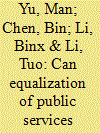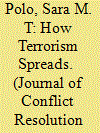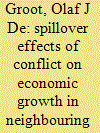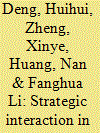|
|
|
Sort Order |
|
|
|
Items / Page
|
|
|
|
|
|
|
| Srl | Item |
| 1 |
ID:
159047


|
|
|
|
|
| Summary/Abstract |
Regional disparities that challenge the economy and public administration must be confronted by the governments and public in developing countries. As the extensive mode of economic growth has caused many problems in China, it is necessary to find other ways to promote the development of poor areas to narrow regional disparities in the country. This paper measures the equalization of public services and residents' living standards in China, based on a provincial panel data for the period 2001–2013, to analyze the impact of the equalization of public services on China's regional disparities. The empirical results, based on spatial econometrics models, show that the equalization of all types of public services can promote the regional equality of incomes and consumptions. There is also evidence suggesting that the regional disparities are affected by other economic and social factors.
|
|
|
|
|
|
|
|
|
|
|
|
|
|
|
|
| 2 |
ID:
162321


|
|
|
|
|
| Summary/Abstract |
By considering spatial relationships, this study aims to analyse to what extent per capita CO2 emissions are determined by renewable energy consumption, the share of the services sector in GDP, energy intensity and real per capita income. A panel data set composed of 173 countries over the 1990–2014 period is used to estimate an environmental Kuznets curve (EKC) augmented by neighbouring per capita income and energy intensity. Both standard and spatial forms are estimated for seven different sets of countries to assess the robustness of the results. Finally, several forecasts are performed to verify global sustainability and to provide some policy suggestions for the period 2015–2100. The empirical results indicate that (i) most areas support the standard EKC, (ii) there seems to be an inverted U-shaped relationship between neighbouring per capita income and national per capita emissions in Europe, Asia and the World as a whole, (iii) neighbouring energy intensity increases national per capita emissions, and (iv) forecasts show that economic growth will accelerate climate change. However, a steady annual growth in renewable energy consumption and a steady decrease in energy intensity, both close to 2.5%, may guarantee environmental sustainability prior to 2100.
|
|
|
|
|
|
|
|
|
|
|
|
|
|
|
|
| 3 |
ID:
175343


|
|
|
|
|
| Summary/Abstract |
Previous research on the causes of domestic terrorism has tended to focus on domestic determinants. Although this approach can be helpful to understand many causes of terrorism, it implicitly disregards how the tactical choices made by similar nonstate actors elsewhere influence a group’s decision to resort to terrorist tactics. This study argues that the adoption of terrorism among ethnic and ethnoreligious groups results from a process of conditional emulation. Groups are more likely to emulate the terrorist choice of others with whom they are connected by shared political grievances and spatial networks. The theory is tested on a new and original group-level data set of ethnic and ethnoreligious terrorism (1970 to 2009) using geospatial analysis and spatial econometric models. The results provide strong support for the hypothesized mechanism leading to the diffusion of terrorism and suggest that emulation—more than domestic and contextual factors—substantially influences dissidents’ tactic choice.
|
|
|
|
|
|
|
|
|
|
|
|
|
|
|
|
| 4 |
ID:
120622


|
|
|
|
|
| Publication |
2013.
|
| Summary/Abstract |
This paper estimates the impact of inter-sectoral linkages on productivity at the sectoral level. An exhaustive Chinese panel data set for capital, infrastructure and a sectoral agglomeration index is linked with an economic distance matrix derived from inter-sectoral transactions. The latter matrix can replace the conventional geographic distance matrix from spatial econometrics. The impact through spillovers is mixed-the direct impact passing to related sectors and back to the initial sector itself, and the indirect impact arising from changes in all sectors. The results suggest that (1) economic growth in a sector is driven by spillovers among sectors that are linked through flows of goods and services; economic distance plays a more important role in stimulating productivity spillover than spatial distance; a shorter economic distance transmits a larger productivity spillover between sectors; (2) infrastructure spillover improves labor productivity in linked sectors; (3) agglomeration diseconomies can be partially reduced by infrastructure investment.
|
|
|
|
|
|
|
|
|
|
|
|
|
|
|
|
| 5 |
ID:
095044


|
|
|
|
|
| Publication |
2010.
|
| Summary/Abstract |
In this article, the influence of conflict on the economies of neighbouring countries is discussed. The results from previous papers show a strong negative effect for an entire area around a country suffering from conflict, but this paper reaches a different conclusion, by using more recent data and adjusting the methodology previously employed. Additionally, a new type of contiguity matrix is constructed and used in the actual analysis. The final analysis consists of a large number of regressions and concludes that conflict actually has two opposing effects. First, like conflict countries themselves, directly contiguous countries actually suffer from the negative effects of proximate conflict. Secondly, however, there is also a positive spillover of conflict, which affects non-contiguous countries and this effect is larger for countries that are closer to the conflict country. The results from the paper predominantly hold for the most violent kind of conflict.
|
|
|
|
|
|
|
|
|
|
|
|
|
|
|
|
| 6 |
ID:
114794


|
|
|
|
|
| Publication |
2012.
|
| Summary/Abstract |
In China, the responsibility of protecting the environment lies largely with local governments. Within the framework of spatial econometrics, we investigate empirically the consequence of such an institutional setting. Using city-level data for China, the present study finds that city governments behave strategically in making spending decisions regarding environmental protection. This paper finds that a city government appears to cut its own spending as a response to the rise in environmental protection spending by its neighbors. Hence, environmental protection tends to be underprovided. As a result, we suggest that centralizing the environmental protection responsibility to a higher level of government would be beneficial in terms of controlling pollution in China.
|
|
|
|
|
|
|
|
|
|
|
|
|
|
|
|
|
|
|
|
|